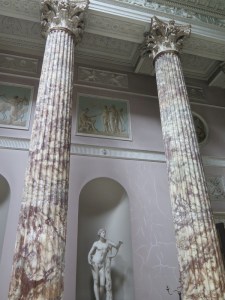Sunday started out and stayed sunny, a trend that supposedly ends tomorrow with two predicted days of rain. With the weather so nice, we both took walks, separately, up to the castle and back. Elaine went early, I went later. Last year on her morning walk up to Dunstanburgh Castle, Elaine met Dorothy, an English lady from Derbyshire, who does the same walk every morning when she and her husband stay in Craster for a week. Since we are here for essentially the same week this year as last, we wondered if we would see Dorothy and Geoffrey again. We both saw Dorothy on our walks, and we spent some time reminiscing. Elaine and Dorothy will meet up at 6:30 AM tomorrow to walk together (weather permitting).
A little more about Dunstanburgh Castle. It has a rich history back to he 14th century, originally a State site for defense from invasions from nearby Scotland. As that need diminished, it passed into private hands. A golf course, still in use, was built in 1900. The state took it over again as an observation post and defensive position against potential German submarine landings in WWII. In the 21st century the castle is owned by the National Trust and run by English Heritage. Here are some more pictures from my walk. Yesterday’s picture were by Elaine on her walk.
Click to enlarge




Later in the morning we drove back roads north for 40 minutes to get to tiny Chillingham, home to a castle and to a preserve for the Wild Cattle of Chillingham. We bought a combined ticket for both sites, but we only visited the Wild Cattle today and will use the castle ticket another day. Wild Cattle, you ask? Yup. Here’s a brief blurb about them, visit the link for more information about this unique breed:
“One of the rarest animals on Earth, a visit to the Wild Cattle of Chillingham makes an absolutely unique day out in beautiful Northumberland. Perhaps for as long as 700 years these remarkable animals have inhabited Chillingham Park. Isolated from all other cattle, they are totally inbred yet remain fit and healthy – a unique situation without parallel in any wild animal anywhere else in the world.“The animals are regarded as a scientific marvel; inbreeding throughout history is well known to lead to extinction because of the small gene pool that the animals share. Studies with the most modern DNA technology show that the cattle have a uniquely high degree of genetic uniformity. However, there is still a small amount of genetic variability between individuals. We don’t yet know if this is the result of chance or if it is in some way related to the survival of this unique population; however the Chillingham Wild Cattle have managed to survive in spite of this, and the herd continues to grow.”
“The beasts are also completely untamed and remain untouched since the medieval ages, so their behaviour is entirely natural and can give us insight into the behaviour of extinct ancestral wild cattle. The cattle breed throughout the year, and the bulls adopt ‘home territories’, plots of the land which they assume as theirs. They share this territory, but do not tend to defend it if other cattle graze in it.”






































































































































































































































